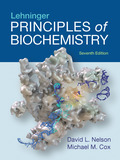
(a)
To determine: Whether HbA or HbF hemoglobin has a higher affinity for oxygen under physiological conditions.
Introduction:
Hemoglobin is the blood protein that carries the oxygen molecule. It is composed of four heme groups which surround the globin group. Heme groups possess iron and provides a red color to the blood cells. Hemoglobin is present in the tetrameric form that consist 2 dimers (α,ß dimmers) that binds to the oxygen molecule. The affinity of oxygen to bind with hemoglobin is isolated from the red blood cells that displays a sigmoidal curve. 2,3- bisphosphoglycerate is a glycolytic intermediate that has an immense affinity for the deoxyhemoglobin molecule.
(b)
To determine: The physiological significance of the different O2 affinities.
Introduction:
Hemoglobin is the blood protein that carries the oxygen molecule. It is composed of four heme groups which surround the globin group. Heme groups possess iron and provides a red color to the blood cells. Hemoglobin is present in the tetrameric form that consist 2 dimers (α, ß dimmers) that binds to the oxygen molecule. The affinity of oxygen to bind with hemoglobin is isolated from the red blood cells that displays a sigmoidal curve. 2,3- bisphosphoglycerate is a glycolytic intermediate that has an immense affinity for the deoxyhemoglobin molecule.
(c)
To determine: The effect of BPG on the oxygen affinity of hemoglobin and explain the different oxygen affinities of fetal and maternal hemoglobin.
Introduction:
Hemoglobin is the blood protein that carries the oxygen molecule. It is composed of four heme groups which surround the globin group. Heme groups possess iron and provides a red color to the blood cells. Hemoglobin is present in the tetrameric form that consist 2 dimers (α,ß dimmers) that binds to the oxygen molecule. The affinity of oxygen to bind with hemoglobin is isolated from the red blood cells that displays a sigmoidal curve. 2,3- bisphosphoglycerate is a glycolytic intermediate that has an immense affinity for the deoxyhemoglobin molecule.
Want to see the full answer?
Check out a sample textbook solution
Chapter 5 Solutions
EBK LEHNINGER PRINCIPLES OF BIOCHEMISTR
- The following data were recorded for the enzyme catalyzed conversion of S -> P. Question: Estimate the Vmax and Km. What would be the rate at 2.5 and 5.0 x 10-5 M [S] ?arrow_forwardPlease helparrow_forwardThe following data were recorded for the enzyme catalyzed conversion of S -> P Question: what would the rate be at 5.0 x 10-5 M [S] and the enzyme concentration was doubled? Also, the rate given in the table is from product accumulation after 10 minuets of reaction time. Verify these rates represent a true initial rate (less than 5% turnover). Please helparrow_forward
- The following data was obtained on isocitrate lyase from an algal species. Identify the reaction catalyzed by this enzyme, deduce the KM and Vmax , and determine the nature of the inhibition by oxaloacetate. Please helparrow_forwardIn the table below, there are sketches of four crystals made of positively-charged cations and negatively-charged anions. Rank these crystals in decreasing order of stability (or equivalently increasing order of energy). That is, select "1" below the most stable (lowest energy) crystal. Select "2" below the next most stable (next lowest energy) crystal, and so forth. A B 鹽 (Choose one) +2 C +2 +2 (Choose one) D 鹽雞 (Choose one) (Choose one)arrow_forward1. Draw the structures for the fats A. 16:2: w-3 and B. 18:3:49,12,15 2. Name each of the molecules below (image attached)arrow_forward
- draw the structures for the fats A. 16:2:w-3 B 18:3:9,12,15arrow_forward1. Below is a template strand of DNA. Show the mRNA and protein that would result. label the ends of the molecules ( refer to attached image)arrow_forwardAttach the followina labels to the diagram below: helicase, single stranded binding proteins, lagging strand, leading strand, DNA polymerase, primase, 5' ends (3), 3' ends (3) (image attached)arrow_forward
- 1. How much energy in terms of ATP can be obtained from tristearin (stearate is 18:0) Show steps pleasearrow_forwardMultiple choice urgent!!arrow_forward1. Write the transamination reaction for alanine. Indicate what happens next to each of the molecules in the reaction, and under what conditions it happens. 2.arrow_forward
 BiochemistryBiochemistryISBN:9781319114671Author:Lubert Stryer, Jeremy M. Berg, John L. Tymoczko, Gregory J. Gatto Jr.Publisher:W. H. Freeman
BiochemistryBiochemistryISBN:9781319114671Author:Lubert Stryer, Jeremy M. Berg, John L. Tymoczko, Gregory J. Gatto Jr.Publisher:W. H. Freeman Lehninger Principles of BiochemistryBiochemistryISBN:9781464126116Author:David L. Nelson, Michael M. CoxPublisher:W. H. Freeman
Lehninger Principles of BiochemistryBiochemistryISBN:9781464126116Author:David L. Nelson, Michael M. CoxPublisher:W. H. Freeman Fundamentals of Biochemistry: Life at the Molecul...BiochemistryISBN:9781118918401Author:Donald Voet, Judith G. Voet, Charlotte W. PrattPublisher:WILEY
Fundamentals of Biochemistry: Life at the Molecul...BiochemistryISBN:9781118918401Author:Donald Voet, Judith G. Voet, Charlotte W. PrattPublisher:WILEY BiochemistryBiochemistryISBN:9781305961135Author:Mary K. Campbell, Shawn O. Farrell, Owen M. McDougalPublisher:Cengage Learning
BiochemistryBiochemistryISBN:9781305961135Author:Mary K. Campbell, Shawn O. Farrell, Owen M. McDougalPublisher:Cengage Learning BiochemistryBiochemistryISBN:9781305577206Author:Reginald H. Garrett, Charles M. GrishamPublisher:Cengage Learning
BiochemistryBiochemistryISBN:9781305577206Author:Reginald H. Garrett, Charles M. GrishamPublisher:Cengage Learning Fundamentals of General, Organic, and Biological ...BiochemistryISBN:9780134015187Author:John E. McMurry, David S. Ballantine, Carl A. Hoeger, Virginia E. PetersonPublisher:PEARSON
Fundamentals of General, Organic, and Biological ...BiochemistryISBN:9780134015187Author:John E. McMurry, David S. Ballantine, Carl A. Hoeger, Virginia E. PetersonPublisher:PEARSON





